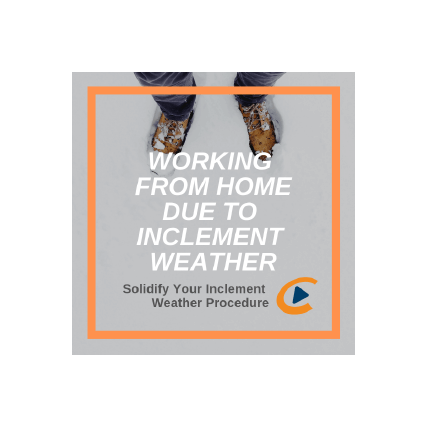Working from Home Due to Inclement Weather

With the blustery cold, black ice, and inches (or realistically, feet) of snow, some businesses have to close their doors and cease productivity when employees cannot get to the office. But with a proper plan and procedure for when the snow hits, a company’s productivity doesn’t have to suffer from a snow day.
To make sure your business doesn’t suffer because of inclement weather, have a proper procedure for allowing employees to work remotely.
Solidify Your Inclement Weather Procedure
To create a good procedure for notifying and allowing employees to work from home, make sure you have an answer to these critical questions:
- When and how do you communicate the situation? Be sure you know how you’ll communicate that you want your employees to stay safe and work from home. In your procedure, set a deadline for when you need to send the communication and make sure to do it early!
- Who sends the communication? Only one person, usually in management, should be responsible for notifying employees to work from home.
- What are the rules? Determine the conditions that would warrant a remote working day, whether they be a driving ban, road closures, temperatures, or something else.
- Who can work remotely? Some employees may be able to perform some or all of their responsibilities from their home. Identify who these employees are and make sure they are the ones to receive the notification to work from home.
- How will employees account for their time from home? You’ll likely want to make sure your employees are staying on top of their responsibilities, so be sure they know how you would like them to report their time to you. Ways that we account for our time working at home include a spreadsheet breakdown or even a descriptive email of the tasks completed at home.
Have the Proper IT Infrastructure
When your employees are working remotely, there are a few considerations for your IT infrastructure. Ensure the following are true to know your systems can handle a remote day:
- All users can be working at one time on remote systems.
- Security will not be compromised by remote workers.
- All employees will have proper connectivity and devices for working from home.
Once your procedure and IT infrastructure are in place for an emergency work-from-home day, be sure you test and review yearly!

Related Insights
Copeland brand refresh five year anniversary
May 11, 2023
It’s hard to believe it’s already been five years since we unveiled our brand refresh. Looking back, it was a pivotal moment for Copeland. It marked a shift in how we presented… Read more
How MSPs can help SMB leaders leverage technology to grow their business
October 20, 2021
Eric Posa, President at Copeland Technology Solutions, will join Nodeware on October 28th, 2021 at 1P EDT to discuss how MSPs can help business leaders grow their business and improve their profitability. During this… Read more
Copeland Newsletter: Autumn Edition
October 29, 2019
Happy fall from the Copeland team! This is the time of year for all things spooky, so we wanted to dedicate this issue to the scariest trend in technology: cyber attacks. Don’t… Read more



